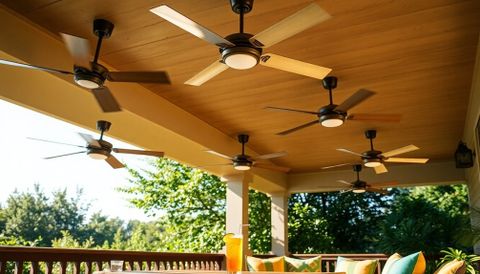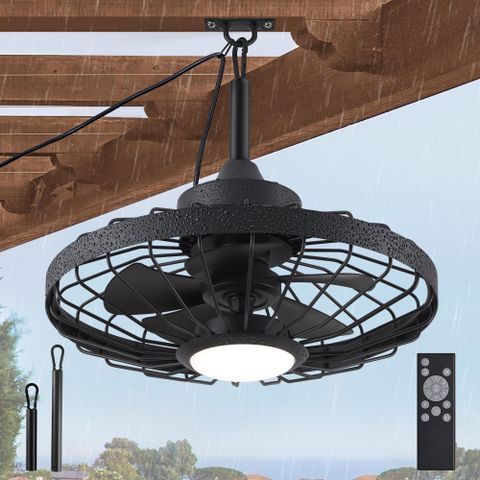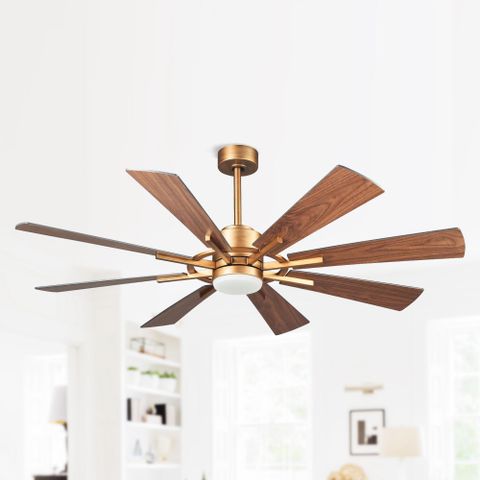Imagine walking into a restaurant where the air feels just right, where the ambiance is inviting, and where every detail works together seamlessly. That’s exactly what happens when you choose the right ceiling fan for your outdoor dining area. It’s not just about spinning blades and airflow – it’s about creating a space where guests feel comfortable and where your business thrives.
When you think about restaurant terraces, the first things that come to mind are often the tables, the lighting, and maybe the view. But there’s one element that quietly transforms the entire experience – the ceiling fan. It might seem like a simple addition, but choosing the right fan for your outdoor space involves careful consideration of form and function. The challenge lies in finding something that doesn’t just cool the air, but also enhances the visual appeal of your establishment. This delicate balance between aesthetics and practicality can make or break the guest experience. What if we told you that getting this right could mean more customers returning, better reviews, and ultimately more business?
Understanding the Unique Challenges of Outdoor Fan Installation
Outdoor terraces present a different set of challenges compared to indoor spaces. Weather exposure, wind conditions, and varying temperatures all play roles in how fans perform. Unlike indoor fans that operate in controlled environments, outdoor fans must withstand rain, humidity, and UV rays. This means materials matter more than ever. Aluminum and stainless steel construction tend to hold up better than plastic alternatives. Consider the mounting options too – some fans require special brackets for outdoor installation.
Think about how many times you’ve seen a fan that looks great but seems to struggle in the heat. The wrong choice can make your terrace feel stuffy or even uncomfortable. A fan that’s too small won’t provide adequate airflow, while one that’s too large might create uncomfortable drafts. And let’s not forget about noise levels – nobody wants to enjoy their meal while being distracted by a fan that’s too loud.
Some restaurant owners make the mistake of prioritizing style over practicality, only to discover later that their chosen fan isn’t actually cooling effectively. Others focus purely on function and end up with something that clashes with their décor. Finding that sweet spot requires understanding what makes a fan truly suitable for outdoor use.
Material Matters: Choosing Durable Outdoor Fan Components
The foundation of any good outdoor ceiling fan lies in its materials. You’re looking for components that can handle the elements without compromising safety or performance. Stainless steel blades are excellent choices because they resist rust and corrosion, while also maintaining their appearance over time. Some manufacturers offer powder-coated finishes that add protection against weather damage.
The motor itself deserves attention too. Look for motors designed specifically for outdoor use – they’re built to handle temperature fluctuations and moisture better than standard indoor models. These motors often come with additional protective features that extend the fan’s lifespan significantly.
Consider the housing material as well. Aluminum enclosures are popular choices because they’re lightweight yet strong enough to protect internal components. Plastic housings may look attractive but often deteriorate faster under constant sun exposure.
What’s really important is finding a balance between durability and visual appeal. You want your fan to look good, but more importantly, you want it to last. Many restaurant owners find that investing in higher-quality materials upfront saves money on replacements and repairs later on. A fan that costs more initially but lasts ten years instead of two is actually a better investment.
Size and Scale: Matching Fan Dimensions to Your Space
One of the most common mistakes restaurant owners make is choosing a fan that’s either too big or too small for their terrace. The size of your ceiling fan directly impacts both its effectiveness and its visual impact. For a typical restaurant terrace, a fan with a blade span of 42 to 54 inches usually works best.
But it’s not just about diameter. You also need to consider the height of your ceiling and the overall scale of your space. A large fan in a low-ceiling area can feel overwhelming, while a small fan in a spacious patio might look lost.
Take a moment to measure your terrace carefully. Think about how many people typically dine there and where they’ll be seated. If you have a long bar area, you might need multiple fans rather than one large unit. Some restaurants use a combination approach – larger fans for main dining areas and smaller ones for more intimate sections.
Remember that fans work best when they’re positioned properly. They should be mounted high enough that people aren’t accidentally brushing against them, but low enough to create effective airflow. The ideal mounting height is typically 8 to 10 feet above the floor.
Consider the shape of your terrace too. Round or square spaces might benefit from different fan configurations. Sometimes a single large fan works perfectly, while other times multiple smaller fans create better coverage.
Design Elements: How Visual Appeal Enhances Customer Experience
Let’s face it – customers want to feel good about where they eat. The visual appeal of your terrace plays a huge role in that feeling. A well-chosen ceiling fan becomes part of the overall aesthetic rather than just a functional element. Think about how fans can complement existing design themes.
Some restaurants opt for industrial-style fans with exposed motors and metal finishes. Others prefer sleek, modern designs that blend seamlessly with contemporary décor. There are even fans that incorporate lighting features, adding another dimension to the space. These aren’t just about cooling – they’re about creating atmosphere.
The color and finish of your fan should harmonize with your existing palette. A fan that’s too bold might clash with delicate table settings, while one that’s too subtle might get lost in the space. The key is finding something that draws attention in a positive way.
Don’t overlook the impact of fan blades themselves. Different blade shapes affect both airflow and visual perception. Curved blades often create smoother airflow, while straighter blades might offer more direct cooling. Some fans even feature decorative elements like crystal accents or unique blade designs that become conversation starters.
Many successful restaurants use fans as focal points. When customers see a stunning fan, it creates a positive impression that extends to everything else about their dining experience. It shows attention to detail and care for their comfort.
Performance Features: What to Look for in Effective Outdoor Cooling
Beyond appearance, outdoor fans need to deliver real cooling performance. Speed control options are essential – you want flexibility to adjust airflow based on weather conditions and customer preferences. Many modern fans offer multiple speed settings, allowing you to fine-tune the experience.
Energy efficiency matters more than you might think. Outdoor spaces often run fans for extended periods, especially during peak seasons. A fan that consumes less electricity not only reduces operating costs but also helps with environmental concerns. Look for fans with energy-efficient motors and LED lighting options when available.
Wind direction control is another valuable feature. Some fans can reverse their rotation, which helps circulate air differently depending on the season. During winter months, reversing the fan can push warm air down from ceilings, improving heating efficiency.
Consider additional features like remote controls or smart home integration. These allow staff to manage fans easily without having to physically access them. Some systems even allow for scheduling, automatically turning fans on or off based on time of day or temperature readings.
The quality of airflow is crucial. You want consistent, gentle movement that cools effectively without creating uncomfortable drafts. Poorly designed fans can create strong gusts that disrupt conversations or make diners uncomfortable. Testing airflow patterns before purchasing can save you from costly mistakes.
Maintenance and Longevity: Ensuring Your Investment Lasts
Choosing a fan that will last requires thinking about maintenance needs. Outdoor fans naturally accumulate dirt, debris, and weather-related wear. Regular cleaning and inspection are necessary for optimal performance. Some fans are easier to maintain than others.
Look for fans with easily accessible blades and components. If you can’t clean the blades regularly, dust buildup will reduce efficiency and potentially cause safety issues. Some manufacturers offer maintenance kits or replacement parts that make upkeep simpler.
Weatherproofing is critical. Check that all connections are sealed properly and that electrical components are protected from moisture. Many outdoor fans come with covers or protective casings that extend their lifespan.
Consider warranty offerings from manufacturers. A good warranty often reflects confidence in product quality. Look for warranties that cover both parts and labor, especially for outdoor installations where access might be challenging.
Planning for the future is also important. Will your restaurant expand or change layout? A fan that’s easy to relocate or reconfigure might prove valuable. Some fans can be moved to different locations within your property, giving you flexibility for seasonal changes or expansion plans.
Remember that proper installation is half the battle. Hiring professionals who understand outdoor fan requirements ensures your investment works as intended. Poor installation can lead to premature failure regardless of how good the fan itself is.
Selecting the right ceiling fan for your restaurant terrace is more than just choosing something that spins. It’s about creating an environment where guests feel comfortable, where your brand identity shines through, and where functionality supports your business goals. The right fan balances visual appeal with practical performance, ensuring that your outdoor space remains inviting year-round.
The key takeaway is that this decision shouldn’t be rushed. Take time to evaluate your space, consider your customers’ needs, and weigh both aesthetic and functional requirements. Remember that a well-chosen fan can transform a simple outdoor dining area into a memorable experience.
Whether you’re renovating an existing terrace or designing a new one, thoughtful fan selection pays dividends in customer satisfaction and operational efficiency. The investment in quality, appropriate-sized fans with durable materials and thoughtful design will show in your guests’ comfort and your bottom line. After all, when people feel good about their dining environment, they’re more likely to return and recommend your establishment to others. That’s the real power of balancing aesthetics and functionality in your outdoor dining space.














